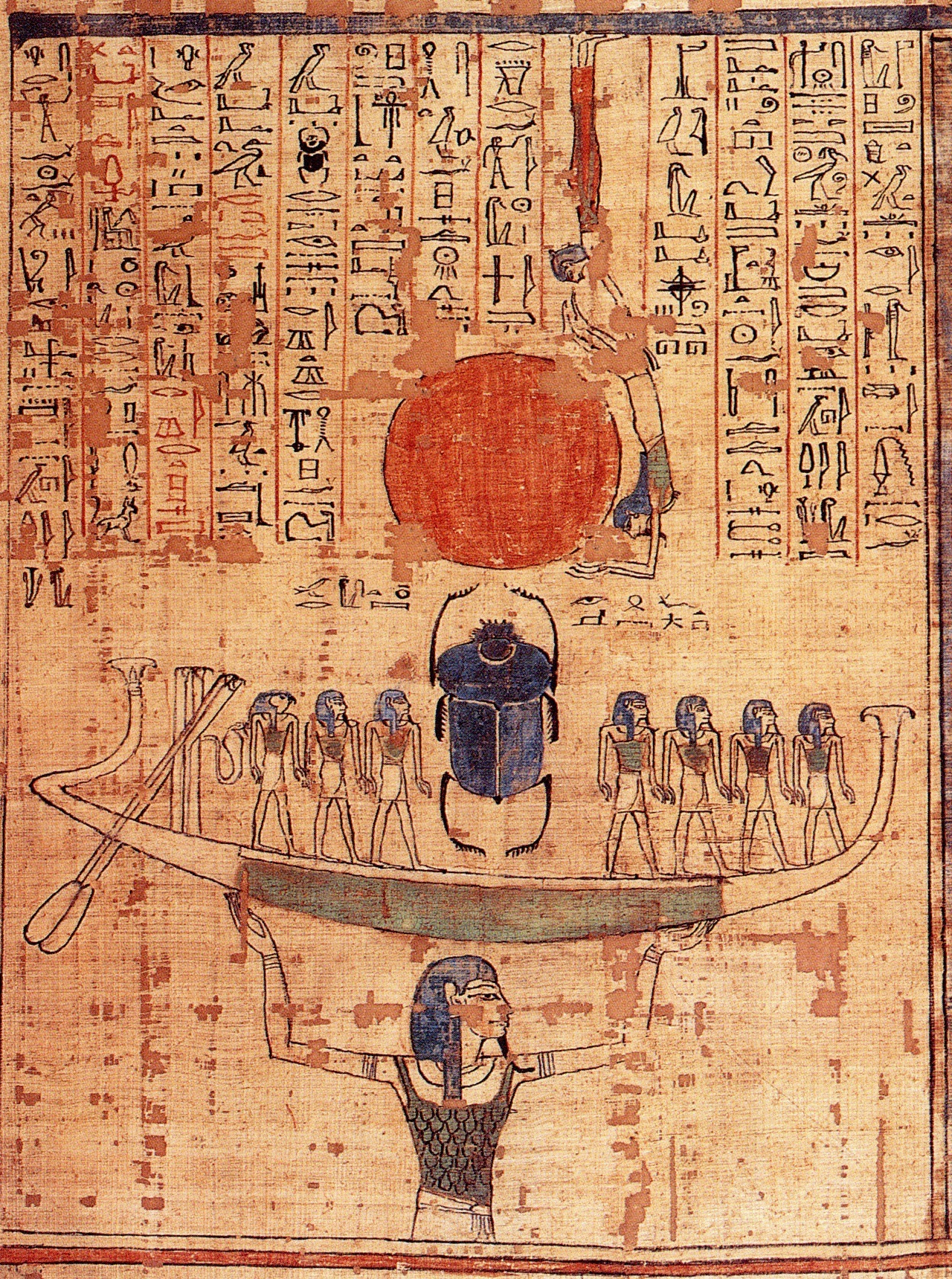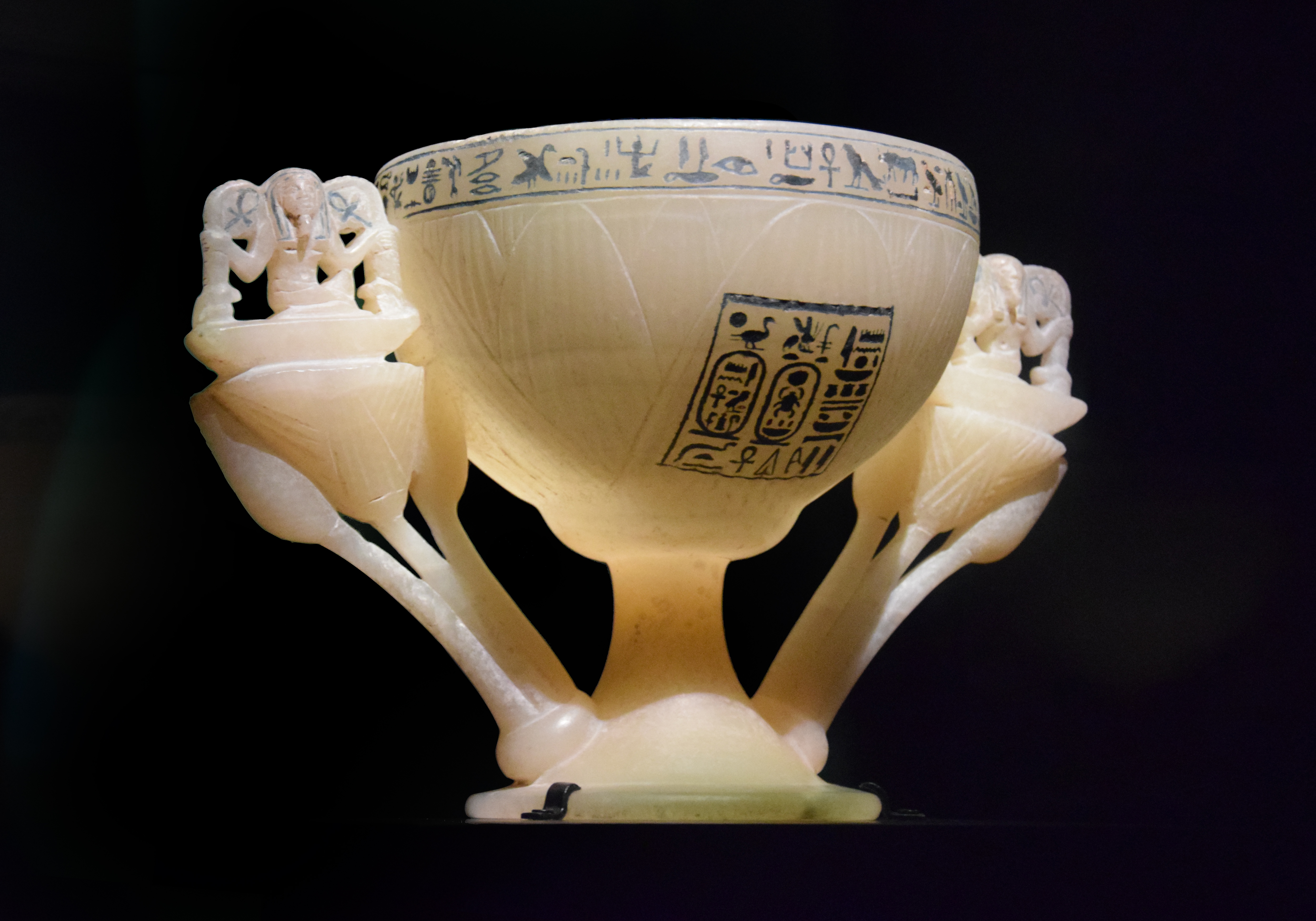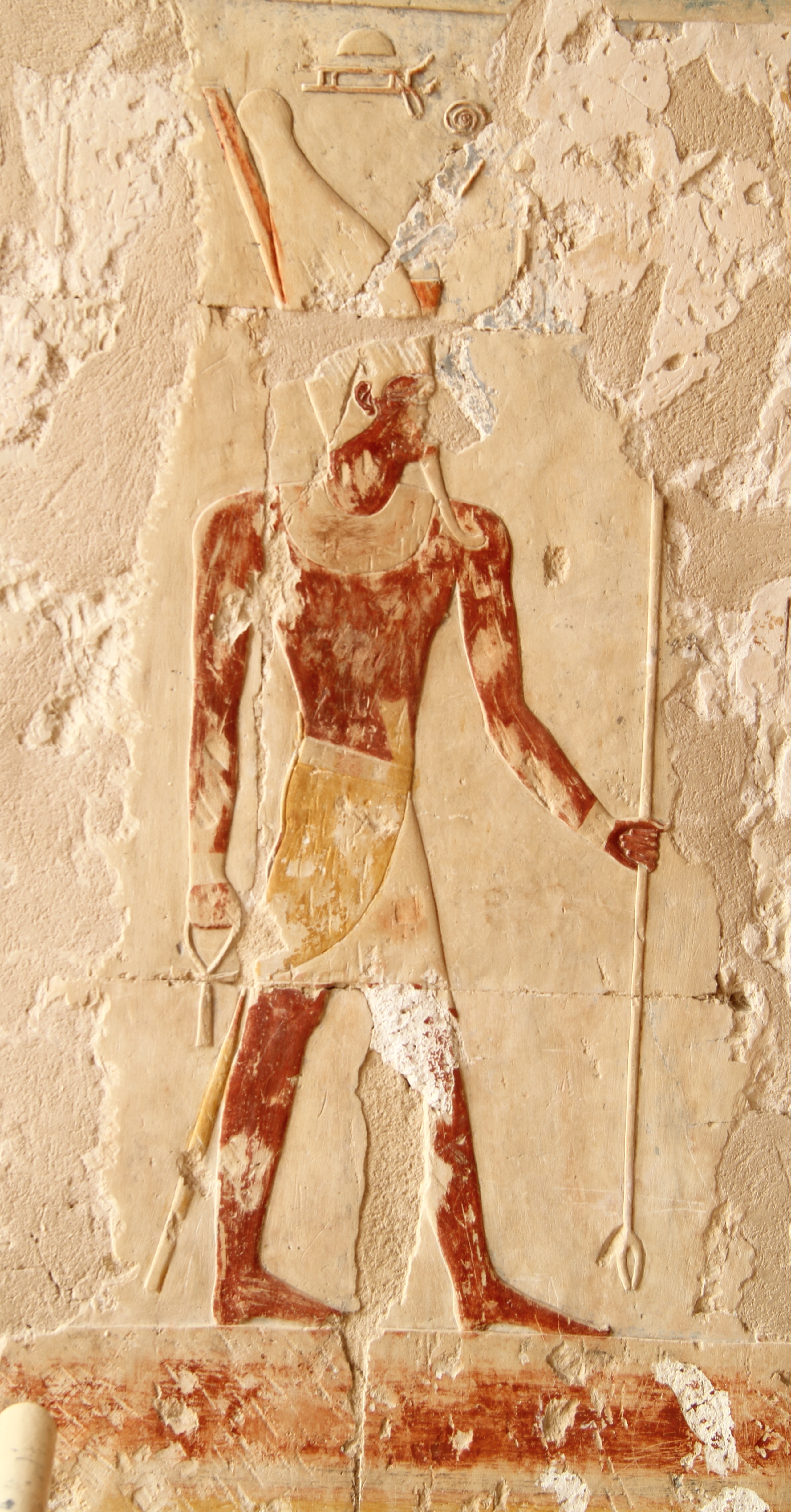|
Hauhet
Ḥeḥ (''ḥḥ'', also Huh, Hah, Hauh, Huah, and Hehu) was the personification of infinity or eternity in the Ogdoad in ancient Egyptian religion.Wilkinson, Richard H. (2003). ''The Complete Gods and Goddesses of Ancient Egypt''. Thames & Hudson. p. 109 His name originally meant "flood", referring to the watery chaos that the Egyptians believed existed before the creation of the world. The Egyptians envisioned this chaos as infinite, in contrast with the finite created world, so Heh personified this aspect of the primordial waters. Heh's female counterpart was known as Hauhet, which is simply the feminine form of his name. Like the other concepts in the Ogdoad, his male form was often depicted as a frog, or a frog-headed human, and his female form as a snake or snake-headed human. The frog head symbolised fertility, creation, and regeneration, and was also possessed by the other Ogdoad males Kek, Amun, and Nun. The other common representation depicts him crouching, holding a ... [...More Info...] [...Related Items...] OR: [Wikipedia] [Google] [Baidu] |
Naunet
Nu ("Watery One") or Nun ("The Inert One") ( Ancient Egyptian: ; Coptic: ), is the personification of the primordial watery abyss which existed at the time of creation and from which the creator sun god Ra arose, in ancient Egyptian religion. Nu is one of the eight deities of the Ogdoad representing ancient Egyptian primordial Chaos from which the primordial mound arose from. Nun can be seen as the first of all the gods and the creator of reality and personification of the cosmos. Nun is also considered the god that will destroy existence and return everything to the Nun from whence it came. No cult was addressed to Nun. The consort of Nun was the goddess Nunut or Naunet ( Ancient Egyptian: ). Name The name on Nu is paralleled with "inactivity" in a play of words in, "I raised them up from out of the watery mass [], out of inactivity []". The name has also been compared to the Coptic ''noun'' "abyss; deep". Origin myth The ancient Egyptians envisaged the oceanic abyss o ... [...More Info...] [...Related Items...] OR: [Wikipedia] [Google] [Baidu] |
Ancient Egyptian Creation Myths
Ancient Egyptian creation myths are the ancient Egyptian accounts of the creation of the world. The Pyramid Texts, tomb wall decorations, and writings, dating back to the Old Kingdom (c. 2700–2200 BCE) have provided the majority of information regarding ancient Egyptian creation myths. These myths also form the earliest religious compilations in the world. The ancient Egyptians had many creator gods and associated legends. Thus, the world or more specifically Egypt was created in diverse ways according to different parts of ancient Egypt. Some versions of the myth indicate spitting, others masturbation, as the act of creation. The earliest god, Ra and/or Atum (both being creator/sun gods), emerged from a chaotic state of the world and gave rise to Shu ( air) and Tefnut (moisture), from whose union came Geb (earth) and Nut ( sky), who in turn created Osiris, Isis, Set, and Nephthys. An extension to this basic framework was the Osiris myth involving Osiris, his consort Isis ... [...More Info...] [...Related Items...] OR: [Wikipedia] [Google] [Baidu] |
Nu (mythology)
Nu ("Watery One") or Nun ("The Inert One") ( Ancient Egyptian: ; Coptic: ), is the personification of the primordial watery abyss which existed at the time of creation and from which the creator sun god Ra arose, in ancient Egyptian religion. Nu is one of the eight deities of the Ogdoad representing ancient Egyptian primordial Chaos from which the primordial mound arose from. Nun can be seen as the first of all the gods and the creator of reality and personification of the cosmos. Nun is also considered the god that will destroy existence and return everything to the Nun from whence it came. No cult was addressed to Nun. The consort of Nun was the goddess Nunut or Naunet ( Ancient Egyptian: ). Name The name on Nu is paralleled with "inactivity" in a play of words in, "I raised them up from out of the watery mass [], out of inactivity []". The name has also been compared to the Coptic ''noun'' "abyss; deep". Origin myth The ancient Egyptians envisaged the oceanic abyss o ... [...More Info...] [...Related Items...] OR: [Wikipedia] [Google] [Baidu] |
Hermopolis
Hermopolis ( grc, Ἑρμούπολις ''Hermoúpolis'' "the City of Hermes", also ''Hermopolis Magna'', ''Hermoû pólis megálẽ'', egy, ḫmnw , Egyptological pronunciation: "Khemenu"; cop, Ϣⲙⲟⲩⲛ ''Shmun''; ar, الأشمونين) was a major city in antiquity, located near the boundary between Lower and Upper Egypt. A provincial capital since the Old Kingdom of Egypt, Hermopolis developed into a major city of Roman Egypt, and an early Christian center from the third century. It was abandoned after the Muslim conquest but was restored as both a Latin Catholic (meanwhile suppressed) and a Coptic Orthodox titular see. Its remains are located near the modern town of el Ashmunein (from the Coptic name) in Mallawi, Minya Governorate, Egypt. Name ''Khemenu'' ('), the Egyptian language name of the city, means "Eight-Town", after the Ogdoad, a group of eight "primordial" deities whose cult was situated there. The name survived as Coptic ''Shmun'', from wh ... [...More Info...] [...Related Items...] OR: [Wikipedia] [Google] [Baidu] |
Tomb Of Tutankhamun
The tomb of Tutankhamun, also known by its tomb number, KV62, is the burial place of Tutankhamun (reigned c. 1334–1325 BC), a pharaoh of the Eighteenth Dynasty of ancient Egypt, in the Valley of the Kings. The tomb consists of four chambers and an entrance staircase and corridor. It is smaller and less extensively decorated than other Egyptian royal tombs of its time, and it probably originated as a tomb for a non-royal individual that was adapted for Tutankhamun's use after his premature death. Like other pharaohs, Tutankhamun was buried with a wide variety of funerary objects and personal possessions, such as coffins, furniture, clothing and jewellery, though in the unusually limited space these goods had to be densely packed. Robbers entered the tomb twice in the years immediately following the burial, but Tutankhamun's mummy and most of the burial goods remained intact. The tomb's low position, dug into the floor of the valley, allowed its entrance to be hidden by debris de ... [...More Info...] [...Related Items...] OR: [Wikipedia] [Google] [Baidu] |
Senusret II
Khakheperre Senusret II was the fourth pharaoh of the Twelfth Dynasty of Egypt. He ruled from 1897 BC to 1878 BC. His pyramid was constructed at El-Lahun. Senusret II took a great deal of interest in the Faiyum oasis region and began work on an extensive irrigation system from Bahr Yussef through to Lake Moeris through the construction of a dike at El-Lahun and the addition of a network of drainage canals. The purpose of his project was to increase the amount of cultivable land in that area. The importance of this project is emphasized by Senusret II's decision to move the royal necropolis from Dahshur to El-Lahun where he built his pyramid. This location would remain the political capital for the 12th and 13th Dynasties of Egypt. The king also established the first known workers' quarter in the nearby town of Senusrethotep ( Kahun). Unlike his successor, Senusret II maintained good relations with the various nomarchs or provincial governors of Egypt who were almost as wealth ... [...More Info...] [...Related Items...] OR: [Wikipedia] [Google] [Baidu] |
Sithathoriunet
Sithathoriunet (her name means “daughter of Hathor of Dendera”) was an Ancient Egyptian ''king's daughter'' of the 12th Dynasty, mainly known from her burial at El-Lahun in which a treasure trove of jewellery was found., p.99 She was possibly a daughter of Senusret II since her burial site was found next to the pyramid of this king. If so, this would make her one of five known children and one of three daughters of Senusret II—the other children were Senusret III, Senusretseneb, Itakayt and Nofret. Sithathoriunet was buried in the Kahun pyramid complex. She must have died while Amenemhat III was pharaoh, since objects with his name were found in her tomb. Her name and titles survived on her canopic jars and on an alabaster vessel found in her tomb. The tomb was excavated in 1914 by Flinders Petrie and Guy Brunton. It had previously been robbed in antiquity but a niche in the burial site escaped the looters' attention. In this niche were found remains of several boxes ... [...More Info...] [...Related Items...] OR: [Wikipedia] [Google] [Baidu] |
Lotus Chalice
The Lotus chalice or Alabaster chalice, called the Wishing Cup by Howard Carter, derives from the tomb of the Ancient Egyptian pharaoh Tutankhamun of the 18th Dynasty. The object received the find number 014 and is now on display in the Egyptian Museum in Cairo, with the inventory numbers JE 67465 and GEM 36. Discovery The tomb of the young king (KV62) was uncovered almost untouched in the Valley of the Kings in West Thebes by Howard Carter on 4 November 1922. The lotus chalice was one of the first objects which Carter and his excavators found on entering the tomb; the vessel was on the floor immediately inside the antechamber. This was not its original position. Material and significance The lotus chalice is carved from a single piece of alabaster. The chalice takes the shape of a white lotus in full bloom, identified by its rounded petals. The supports for the handles are shaped like blue lotus flowers which are flanked by buds growing upward, with the god Heh seate ... [...More Info...] [...Related Items...] OR: [Wikipedia] [Google] [Baidu] |
Tutankhamun
Tutankhamun (, egy, twt-ꜥnḫ-jmn), Egyptological pronunciation Tutankhamen () (), sometimes referred to as King Tut, was an Egyptian pharaoh who was the last of his royal family to rule during the end of the Eighteenth Dynasty (ruled in the conventional chronology) during the New Kingdom of Egyptian history. His father is believed to be the pharaoh Akhenaten, identified as the mummy found in the tomb KV55. His mother is his father's sister, identified through DNA testing as an unknown mummy referred to as " The Younger Lady" who was found in KV35. Tutankhamun took the throne at eight or nine years of age under the unprecedented viziership of his eventual successor, Ay, to whom he may have been related. He married his paternal half-sister Ankhesenamun. During their marriage they lost two daughters, one at 5–6 months of pregnancy and the other shortly after birth at full-term. His names—''Tutankhaten'' and ''Tutankhamun''—are thought to mean "Living image of At ... [...More Info...] [...Related Items...] OR: [Wikipedia] [Google] [Baidu] |
Old Kingdom
In ancient Egyptian history, the Old Kingdom is the period spanning c. 2700–2200 BC. It is also known as the "Age of the Pyramids" or the "Age of the Pyramid Builders", as it encompasses the reigns of the great pyramid-builders of the Fourth Dynasty, such as King Sneferu, who perfected the art of pyramid-building, and the kings Khufu, Khafre and Menkaure, who constructed the pyramids at Giza. Egypt attained its first sustained peak of civilization during the Old Kingdom, the first of three so-called "Kingdom" periods (followed by the Middle Kingdom and New Kingdom), which mark the high points of civilization in the lower Nile Valley. The concept of an "Old Kingdom" as one of three "golden ages" was coined in 1845 by the German Egyptologist Baron von Bunsen, and its definition would evolve significantly throughout the 19th and the 20th centuries. Not only was the last king of the Early Dynastic Period related to the first two kings of the Old Kingdom, but the "cap ... [...More Info...] [...Related Items...] OR: [Wikipedia] [Google] [Baidu] |
Atum
Atum (, Egyptian: ''jtm(w)'' or ''tm(w)'', ''reconstructed'' ; Coptic ''Atoum''), sometimes rendered as Atem or Tem, is an important deity in Egyptian mythology. Name Atum's name is thought to be derived from the verb ''tm'' which means 'to complete' or 'to finish'. Thus, he has been interpreted as being the "complete one" and also the finisher of the world, which he returns to watery chaos at the end of the creative cycle. As creator, he was seen as the progenitor of the world, the deities and universe having received his vital force or ka. Origins Atum is one of the most important and frequently mentioned deities from earliest times, as evidenced by his prominence in the Pyramid Texts, where he is portrayed as both a creator and father to the king. Several writings contradict how Atum was brought into existence. Some state Atum was created by himself by saying his name, while others argue he came out from a blue lotus flower or an egg. Role In the Heliopolitan creation myt ... [...More Info...] [...Related Items...] OR: [Wikipedia] [Google] [Baidu] |








